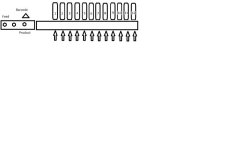I am using a compactLogix PLC. We built a conveyor system now we have added an end of line sorter. Yes an add on and no one has thought of how it is to work just fabricated it and left it to me to sort out the control.
It has a long conveyor with 12 Stations.
There are 12 chutes along the length on the left hand side, and on the right hand side is 12 pushers and each of the twelve pushing stations has a sensor so I know product is in one of the 12 pusher area's at any one time.
At the beginning of the conveyor is a barcode reader that I read the barcode of the product and then query SQL and get the station number the product must go to.
At first I thought easy get the station number and once on the sorting conveyor (faster than the feed conveyor)send it to its station number and push whilst stopping the feed conveyor - once complete send the next product ie one at a time.
But ideally the customer doesn't want the feed conveyor stopping as it causes a traffic jam. I have been thinking 2D matrix etc etc but it keeps getting complicated ie counting etc problem is product can go to any sorting station in any order.
Dribbling at the moment....
Any suggestions please..

It has a long conveyor with 12 Stations.
There are 12 chutes along the length on the left hand side, and on the right hand side is 12 pushers and each of the twelve pushing stations has a sensor so I know product is in one of the 12 pusher area's at any one time.
At the beginning of the conveyor is a barcode reader that I read the barcode of the product and then query SQL and get the station number the product must go to.
At first I thought easy get the station number and once on the sorting conveyor (faster than the feed conveyor)send it to its station number and push whilst stopping the feed conveyor - once complete send the next product ie one at a time.
But ideally the customer doesn't want the feed conveyor stopping as it causes a traffic jam. I have been thinking 2D matrix etc etc but it keeps getting complicated ie counting etc problem is product can go to any sorting station in any order.
Dribbling at the moment....
Any suggestions please..








